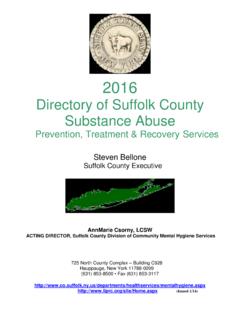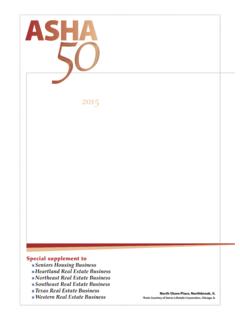Transcription of CONNECTICUT ACCESS TO RECOVERY
1 Thomas A. Kirk, Jr., , CommissionerThomas A. Kirk, Jr., , CommissionerDepartment of Mental Health and Addiction ServicesDepartment of Mental Health and Addiction ServicesA Healthcare Service AgencyA Healthcare Service AgencyJune 2006 June 2006 CONNECTICUTCONNECTICUTACCESS TO RECOVERYACCESS TO RECOVERYF ederal Substance Abuse and Mental Health Service AdministrationNational Advisory CouncilGetting StartedWe are a healthcare service healthRecover and sustain healththrough prevention and early intervention treatment and RECOVERY support services .
2 Addicts a chronic, relapsing disease severe persistent mental illness Doesn t anybody ever get better?What message are we conveying?Substance Abuse as too often viewed by Substance Abuse as too often viewed by the the funderfunderand/or service providerand/or service provider0100 SymptomsTimePerson s Entry into treatmentDischargeSevereRemissionService ResponseService Response0100 SymptomsTimeAcute symptomsDiscontinuous treatmentCrisis managementSevereRemissionRecoveryRecover y--oriented responseoriented response0100 SymptomsTimeContinuous treatment responsePromote Self Care.
3 RehabilitationSevereRemissionMany Paths to RECOVERY Many Paths to RECOVERY DMHAS APPROACHDMHAS APPROACHS ervice System StrategiesService System StrategiesI. RECOVERY Oriented Service SystemII. Value ToolsHow Does ATR Fit Into CTHow Does ATR Fit Into CT s s Larger Picture?Larger Picture? ATR is not just another program, it represents a significant investment in the promotion and enhancement of the Department s overarching goal of a RECOVERY -oriented system of care ATR builds upon a combination of previously undertaken steps and programsConnecticut s ATR Model High degree of collaboration with other targeted state agencies Five regional networks -a total of 36 clinical and 130 RECOVERY providers (including peer and faith-based)
4 To ensure client choice One lead agency in each network assisting with implementation, certification of providers, auditing, Agencies & Programs Department of Correction Judicial Branch Department of Children and Families Department of Social services Primary Healthcare Sites (Hospital ED & FQHC Sites) DMHAS-funded Outreach & Engagement Urban InitiativesClinical ServicesClinical services EvaluationEvaluation Brief TreatmentBrief Treatment Ambulatory DetoxificationAmbulatory Detoxification Intensive Outpatient (IOP)Intensive Outpatient (IOP) Methadone MaintenanceMethadone Maintenance Recently implemented: an evidenced Recently implemented.
5 An evidenced based model of IOP for individuals using based model of IOP for individuals using cocaine and/or methamphetaminescocaine and/or methamphetaminesRecovery Support ServicesRecovery Support services ShortShort--term Housingterm Housing Case ManagementCase Management ChildcareChildcare TransportationTransportation Vocational/Educational ServicesVocational/Educational services Basic Needs (food, clothing, personal care)Basic Needs (food, clothing, personal care) FaithFaith--based Servicesbased services PeerPeer--based Servicesbased ServicesTwo thirdsTwo thirdsof CTof CT s ATR service budget is invested in s ATR service budget is invested in RECOVERY Support services , not clinical Support services , not clinical are RECOVERY Support services ?
6 What are RECOVERY Support services ?Complement the focus of treatment, outreach, engagement, and other strategies and interventions to assist people in establishing an environment supportive of RECOVERY and in gaining the skills and resources needed to initiate and maintain use,Symptoms,Relapse TriggersRecovery CapitalTreatmentRecovery SupportsRecovery Capital is .. RECOVERY Capital is .. the quantity and quality of both internal the quantity and quality of both internal and external resources that a person can and external resources that a person can bring to bear on the initiation and bring to bear on the initiation and maintenance of recoverymaintenance of RECOVERY (W.)
7 White, 2006) (W. White, 2006) In contrast to people who achieve In contrast to people who achieve naturalnatural RECOVERY (without care), most people with RECOVERY (without care), most people with addictive disorders entering treatment have addictive disorders entering treatment have never had much RECOVERY capital or have never had much RECOVERY capital or have dramatically depleted such capital by the dramatically depleted such capital by the time they seek help. time they seek help. RECOVERY Support services aim to: RECOVERY Support services aim to.
8 1)1)remove personal and environmental obstacles remove personal and environmental obstacles to RECOVERY ( , through the provision of child to RECOVERY ( , through the provision of child care or transportation)care or transportation)2)2)enhance identification of and participation in enhance identification of and participation in the RECOVERY community ( , through the RECOVERY community ( , through connecting people to treatment and to 12connecting people to treatment and to 12--step step and other mutual support/recoveryand other mutual support/ RECOVERY --oriented oriented groups) groups) 3)3)
9 Enhance the personenhance the person s s RECOVERY capitalrecovery capital ( , ( , by assisting people in addressing their basic by assisting people in addressing their basic needs, gaining employment, going back to needs, gaining employment, going back to school, forming sober social relationships, etc.)school, forming sober social relationships, etc.)Year To DateAugust 3, 2004 June 11, 2006 10,158 Unduplicated Individuals Served10,158 Unduplicated Individuals Served Year 1 Total Unduplicated Individuals: 106 Year 1 Total Unduplicated Individuals: 106 Year 2 Total Unduplicated Individuals: 10,032 Year 2 Total Unduplicated Individuals.
10 10,032 Received over 75,000 service level Received over 75,000 service level authorizations (clinical and/or RECOVERY authorizations (clinical and/or RECOVERY support services )support services ) $10,228,529 total paid claims$10,228,529 total paid claimsDMHAS established new supportive housing units for over 550 people with psychiatric or substance use disorders. Over 60% of these people are now working or in training, and their inpatient costs have decreased 70%.Based on a Corporation for Supportive Housing study, these supportive housing units are projected to generate over $140 million in direct and indirect economic benefits for the state.
















